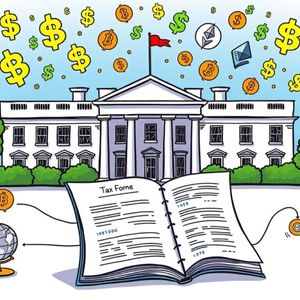BitcoinWorld Monumental Bitcoin Whale Transfer Rocks Coinbase: What It Means for Investors In the dynamic world of cryptocurrency, certain events capture attention more than others. One such occurrence recently sent ripples through the market: a monumental Bitcoin whale transfer . Whale Alert, a prominent blockchain tracking service, reported a significant movement of 7,625 BTC from Coinbase, one of the largest cryptocurrency exchanges, to an unknown new wallet. Valued at approximately $904 million at the time of the transaction, this single move instantly became a focal point of discussion among traders, analysts, and enthusiasts alike. What does such a colossal transaction signify, and what implications does a Bitcoin whale transfer hold for the broader market? Understanding the Giants: What is a Bitcoin Whale Transfer ? Before diving into the specifics of this particular event, it’s crucial to understand the terminology. In the crypto lexicon, a ‘whale’ refers to an individual or entity holding a vast amount of cryptocurrency, enough to potentially influence market prices with their buying or selling activities. A ‘whale transfer’ is simply the movement of a large sum of cryptocurrency from one wallet to another, often triggering speculation about their intentions. Definition of a Whale: While there’s no official threshold, generally, anyone holding over 1,000 BTC is considered a Bitcoin whale. These entities often include early adopters, institutional investors, exchanges, or even large funds. Why They Matter: The sheer volume of their holdings means their actions can create significant price volatility. A large sale could trigger a market downturn, while a large accumulation might signal bullish sentiment. Role of Whale Alert: Services like Whale Alert track these massive transactions across various blockchains, providing transparency and real-time insights into the movements of these large holders. Deconstructing the $904 Million Move: The Coinbase Exodus The recent transfer involved 7,625 BTC originating from Coinbase, a U.S.-based exchange known for its high liquidity and institutional client base. The destination? An ‘unknown new wallet’. This detail is particularly significant, as the nature of the receiving wallet often provides clues about the whale’s intentions. Source (Coinbase): Transfers from exchanges like Coinbase can indicate several things. It could be an institutional client moving funds to cold storage, an over-the-counter (OTC) deal being settled, or even an internal rebalancing by the exchange itself, though the latter is less common for such a specific amount to an ‘unknown new wallet’. Destination (Unknown New Wallet): The ‘unknown’ aspect means the wallet address has no public association with an exchange, known institution, or custodial service. This often points towards private cold storage, a newly created wallet for a specific purpose, or an OTC desk’s receiving address. Value Proposition: At nearly a billion dollars, this Bitcoin whale transfer is not just a routine transaction; it’s a statement of significant capital movement, demanding attention from market observers. What Motivates a Bitcoin Whale Transfer ? Exploring the Possibilities When such a substantial amount of Bitcoin moves, the crypto community immediately begins to speculate on the ‘why’. There are several common reasons for a large Bitcoin whale transfer : 1. Enhanced Security (Cold Storage): One of the most common and often bullish interpretations is that the whale is moving funds from an exchange (hot wallet) to a private, offline cold storage wallet. This is done for maximum security, protecting assets from potential exchange hacks or regulatory risks. It suggests a long-term holding strategy, as moving funds out of an exchange makes them less readily available for immediate sale. 2. Over-the-Counter (OTC) Deals: Large institutional investors or high-net-worth individuals often execute trades through OTC desks to avoid impacting market prices. If a large buyer acquires BTC via an OTC deal, the seller might transfer the Bitcoin from an exchange to the buyer’s designated wallet. This transaction is typically private and doesn’t appear on public order books, making it a common reason for large, seemingly unexplained transfers. 3. Preparing for Sale (Exchange Deposit): Conversely, if the funds were moved to an exchange from an unknown wallet, it might signal an intent to sell. However, in this case, the movement was from an exchange, which generally points away from an immediate sell-off. 4. Portfolio Rebalancing or Custodial Shifts: Large entities, including investment funds or corporate treasuries, frequently rebalance their portfolios or shift assets between different custodial solutions. This could involve moving funds between different types of wallets or even between different custodians for diversification or strategic reasons. 5. Internal Transfers: While less likely for a specific amount to an ‘unknown new wallet’, exchanges or large custodians sometimes perform internal transfers for operational purposes, such as consolidating funds or moving them between different tiers of cold storage. Does a Bitcoin Whale Transfer Signal a Market Shift? The immediate reaction to a large Bitcoin whale transfer is often a mix of curiosity and concern. Will this lead to a price dump? Is someone accumulating before a bull run? The truth is, it’s rarely black and white. Potential for Volatility: While the transfer itself doesn’t directly impact price, the perception of its intent can. If the market believes a whale is preparing to sell, it can trigger fear and lead to selling pressure. Conversely, if it’s seen as accumulation for cold storage, it can instill confidence. The FUD Factor: Fear, Uncertainty, and Doubt (FUD) often accompany such large movements. It’s crucial for investors to look beyond the headlines and analyze the context. A transfer from an exchange to an unknown wallet is generally less bearish than a transfer to an exchange. Historical Context: History shows that not all large transfers lead to immediate price action. Many large transfers are simply operational or security-related moves. The market’s reaction often depends on the prevailing sentiment and other macroeconomic factors at the time. To illustrate the varying implications, consider this simple breakdown: Transfer Type Typical Implication Exchange to Unknown Wallet Often bullish or neutral (cold storage, OTC acquisition) Unknown Wallet to Exchange Potentially bearish (preparing to sell) Exchange to Exchange Neutral (arbitrage, trading strategy) Navigating the Waves: Actionable Insights for Crypto Investors For the average investor, a large Bitcoin whale transfer can be unsettling. However, reacting impulsively is rarely the best strategy. Here are some actionable insights: Don’t Panic: A single large transaction, even one as significant as 7,625 BTC, does not automatically dictate market direction. Look at the broader market trends, macroeconomic factors, and overall on-chain data. Understand Context: Always consider the source and destination of the transfer. As discussed, a move from an exchange to an unknown wallet is often less concerning than the reverse. Monitor On-Chain Metrics: Tools that track exchange inflows/outflows, stablecoin movements, and mining difficulty can provide a more comprehensive picture than a single whale transaction. Diversify Your Portfolio: Don’t put all your eggs in one basket. A diversified portfolio can help mitigate risks associated with sudden market movements influenced by large holders. Stay Informed, Not Overwhelmed: While it’s good to be aware of whale movements, avoid getting caught up in sensationalist headlines. Focus on reliable data and informed analysis. The Broader Picture: Institutional Interest and Market Maturation These large Bitcoin whale transfer events also serve as a reminder of the evolving nature of the crypto market. As Bitcoin gains more mainstream acceptance and institutional interest, such significant movements become more frequent. What might have been considered an alarming event years ago is now often viewed through the lens of institutional operations, OTC deals, and sophisticated cold storage strategies. The presence of large players, while capable of influencing short-term volatility, also signifies growing confidence and adoption. It suggests that Bitcoin is increasingly being treated as a serious asset class, attracting capital from entities with long-term investment horizons. This maturation process is a critical step towards Bitcoin’s continued integration into the global financial system. The 7,625 BTC transfer from Coinbase to an unknown new wallet is undoubtedly a significant event in the crypto world. While its exact purpose remains undisclosed, the analysis of such a Bitcoin whale transfer provides valuable insights into market dynamics, security practices, and the growing institutionalization of cryptocurrency. Rather than a cause for alarm, it serves as a powerful reminder of the substantial capital flowing into the Bitcoin ecosystem and the diverse strategies employed by its largest holders. For investors, the key lies in informed observation, understanding the potential reasons behind such movements, and making decisions based on comprehensive market analysis rather than immediate emotional responses. The world of crypto is constantly moving, and understanding the whales is a vital part of navigating its vast oceans. Frequently Asked Questions (FAQs) Q1: What is a Bitcoin whale? A1: A Bitcoin whale is an individual or entity that holds a very large amount of Bitcoin, typically over 1,000 BTC, giving them the potential to significantly influence market prices with their transactions. Q2: Why are Bitcoin whale transfers important to track? A2: Tracking a Bitcoin whale transfer helps observers understand potential market shifts. Large movements can indicate a whale’s intent to sell, accumulate for long-term holding, engage in OTC deals, or simply rebalance their portfolio, all of which can affect market sentiment and price volatility. Q3: Does a transfer from an exchange to an unknown wallet mean a price drop is coming? A3: Not necessarily. A transfer from an exchange to an unknown wallet is often interpreted as a move to cold storage for long-term holding, an OTC deal, or a custodial shift, which are generally considered neutral to bullish signals, as the Bitcoin is being taken off the immediate market supply. Q4: How can I track Bitcoin whale transfers myself? A4: Services like Whale Alert provide real-time updates on large cryptocurrency transactions across various blockchains. Additionally, many on-chain analytics platforms offer tools to track exchange inflows/outflows and large wallet movements. Q5: What is the significance of Coinbase in this transfer? A5: Coinbase is a major U.S. exchange with a strong institutional client base. A large transfer from Coinbase often suggests involvement from a significant institutional investor or a high-net-worth individual, rather than a smaller retail trader. Share this insightful analysis with your network and help others understand the fascinating world of crypto whale movements! Your shares help us bring more valuable content to the community. To learn more about the latest crypto market trends, explore our article on key developments shaping Bitcoin institutional adoption. This post Monumental Bitcoin Whale Transfer Rocks Coinbase: What It Means for Investors first appeared on BitcoinWorld and is written by Editorial Team















